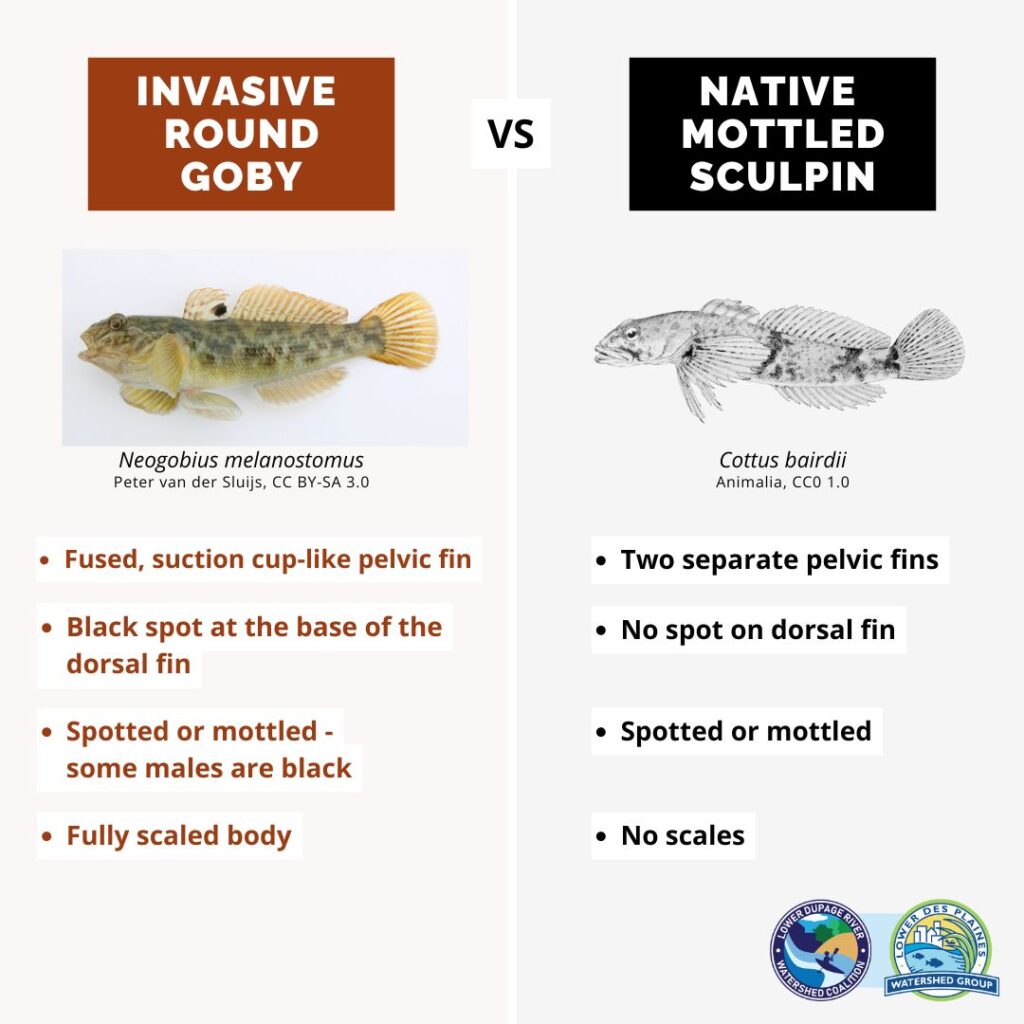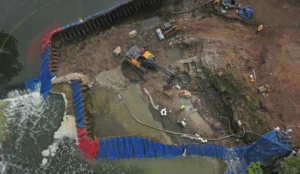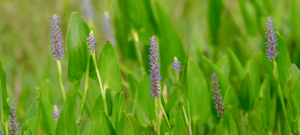The Round Goby, Neogobius melanostomus, is an invasive species of fish that harms native fish populations, which creates a ripple effect in the ecosystem, local economy, and recreational uses of our waterways. This blog post aims to bring awareness to the invasive round goby before irreversible damage is done to rivers, streams, and lakes throughout the United States.
The Problem with Round Gobies at a Glance
Understanding the impact of round gobies is crucial for protecting our waterways. Here are the key points you need to know:
- Origins: Round gobies are invasive fish from Eurasia now commonly found in Illinois waterways.
- Ecosystem Disruption: They reproduce rapidly, eat native fish eggs, and can transmit diseases to native wildlife.
- Stop the spread: Anglers can prevent transporting round gobies to new waterways by not using round gobies as live bait and cleaning fishing gear.
Round Goby: Description and Identification
The round goby is a small, bottom dwelling fish with a cylindrical body and a rounded snout. As adults, they are typically between 2.5 and 6 inches (6-16 cm) in length [1]. Round gobies vary in color. They are often brown with dark brown and black spots; however, males can appear mostly black [2]. Also, older gobies can have a white to greenish dorsal fin, with a black spot at the base of this fin [1].
Round gobies look similar to another fish in our streams: the mottled sculpin, Cottus bairdii. Because the mottled sculpin is a native, state-threatened species, it is important to correctly identify round gobies and mottled sculpins. Keep an eye out for the main distinguishing feature between the two: a fused pelvic fin on the round gobies. This fused pelvic fin—the fin on the bottom of the fish, near their chest—allows gobies to climb some surfaces [3]. Mottled sculpins do not have this, and instead have two separate fins [1]. Another difference is that the round goby has a fully scaled body while the mottled sculpin has no scales.

Round Gobies Disrupt Aquatic Ecosystems
Round gobies are an invasive species in our waterways. The introduction of invasive species can reduce native biodiversity and degrade pre-existing habitat as invasive species compete with native organisms for limited resources.
An invasive species is a non-native (or alien) to the ecosystem under consideration and a species whose introduction causes or is likely to cause economic harm, environmental harm, or harm to human health. -Executive Order 13112, U.S. Department of Agriculture.
In turn, these ecosystem disruptions can result in direct or indirect economic impacts, such as agricultural productivity or even property values, respectively [4]. Aquatic invasive species can lower water quality and limit outdoor recreational opportunities as well [5]. It is estimated that invasive species cost the U.S more than $21 billion per year, most of which is related to resource damages and loses [6], but also to the cost of invasive species control efforts [4].
Specifically, round gobies are a threat to the health of local rivers and streams for a few reasons:
- Round gobies aggressively feed on small aquatic organisms. They can decrease the levels of native fish species, including sport fish, by eating their eggs [7].
- They reproduce quickly, up to six times a summer. Their fast reproduction and predation of native fish eggs can allow them to outcompete native fish [7].
- Round gobies can transmit disease to native fish species. They are a carrier for viral hemorrhagic septicemia (VHS), a fatal disease for many native fish species, and may pass on a strain of botulism from invasive, disease-carrying Zebra mussels [1].


How the Round Goby Invaded Local Water Bodies
Round gobies are native to Central Eurasia—so how did they get to the United States? There are three ways round gobies have spread:
- They can hitch a ride in the ballast water of ships. This method is thought to be the way that round gobies were originally introduced to the Great Lakes in the early 1990s from the Black Sea [6]. Ballast water is water that is pumped in and pumped out of ships when cargo is unloaded or loaded, respectively. This allows for the transport of water from different bodies across great distances. To control the spread of invasives, international legislation now requires ships with ballasts to have ballast water treatment systems [8].
- Anglers can spread round gobies to nearby waterways. Round gobies are transported to new bodies of water through bait buckets, baitwells, and other fishing equipment [7].
- Finally, round gobies can swim through natural and man-made rivers or channels [7]. Interestingly, they can also use their pelvic fin like a suction cup to climb over some obstacles [3 and 9].
Anglers Can Do Their Part to Protect Native Fish
One of the most practical actions we can do to protect local streams and native fish is to prevent the further spread of invasive species like round gobies. Anglers, in particular, can play an important role. Round gobies are often transported to new bodies of water through live bait and fishing equipment, so a few simple steps can limit their spread. When fishing, anglers should:
- Choose other species for live bait. Using round gobies as bait allows them to spread to new areas and is not permitted. Learn to identify round gobies and choose a different kind of live bait to protect native fish.
- Drain all water from boat and gear. Round gobies and other aquatic invasive species can hide in fishing gear. Pull drain plugs and remove water from all equipment. Check bait containers, ballast tanks, motors, and livewells. [10]
- Clean out mud, plants, and animals from all gear. Take a few minutes to rinse out your boat and gear if possible. Ideally, equipment should be dried and let to sit for a few days before entering another body of water. [10]
Protect our Rivers Today for Generations Tomorrow
The round goby continues to travel further across the United States and has even reached the southern-most point of Illinois [11]. They have the potential to spread further South and eventually into the Gulf of Mexico. Since round gobies disrupt local ecosystems and cause secondary impacts on the economy and recreational activities, it is crucial to limit their range. Play a part in stopping the spread of invasive species like round goby to help ensure future generations are able to enjoy and make use of the waterways as we do now.
References:
- “Round Goby,” Invasive Species Centre, April 1, 2022. https://www.invasivespeciescentre.ca/invasive-species/meet-the-species/fish-and-invertebrates/round-goby/.
- Synyshyn, Caitlyn. 2019. “Small but Complicated: Round Goby Males Lead Two Different Lives.” The Habitat Section of the American Fisheries Society. January 1, 2019. https://habitat.fisheries.org/small-but-complicated-round-goby-males-lead-two-different-lives/.
- Bussmann, Karen, Philipp Emanuel Hirsch, Moritz F. Lehmann, and Patricia Burkhardt‐Holm. 2022. “Differential Habitat Use of a Notorious Invasive Fish, the Round Goby, in a Translocation‐Relevant System.” Ecology and Evolution 12 (8). https://doi.org/10.1002/ece3.9202.
- U.S. Department of Agriculture. 2012. “Invasive Species Resources: Economic and Social Impacts.” National Invasive Species Information Center. 2012. https://www.invasivespeciesinfo.gov/subject/economic-and-social-impacts.
- “The Economic Impact of Invasive Species in the United States.” n.d. https://www.maine.gov/dacf/php/documents/nisaweconomics.pdf.
- Sheridan, Kerry. 2022. “Invasive Species Cost the US $21 Billion per Year, Study Finds.” WUSF Public Media. January 4, 2022. https://www.wusf.org/local-state/2022-01-04/invasive-species-cost-the-us-21-billion-per-year-study-finds.
- New York State. n.d. “Round Goby .” Department of Environmental Conservation. https://dec.ny.gov/nature/animals-fish-plants/round-goby.
- Lindholm, Stephen M. 2018. “Ballast Water Management: History, Application, and Legislation.” EDT Forensic Engineering & Consulting. March 21, 2018. https://www.edtengineers.com/blog-post/ballast-water-management-history-application-and-legislation.
- “Status and Strategy for Round Goby Management.” n.d. Michigan Invasive Species. https://www.michigan.gov/-/media/Project/Websites/invasives/Documents/Response/Status/egle-ais-neogobius-melanostomus.pdf?rev=e7eb7847178f4d91af10917bea2b8d8a.
- “Transport Zero – Aquatic.” 2015. Transport Zero. 2015. https://www.transportzero.org/aquatic.html.
- Freedman, J.A., Fuller, P., Benson, A., Maynard, E., Neilson, M.E., Larson, J., Fusaro, A., and Sturtevant, R. 2023. “Round Goby (Neogobius Melanostomus).” U.S. Geological Survey, Nonindigenous Aquatic Species Database. August 29, 2023. https://nas.er.usgs.gov/queries/factsheet.aspx?SpeciesID=713.




